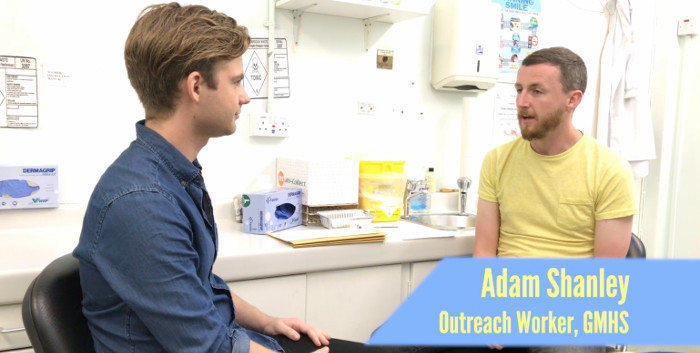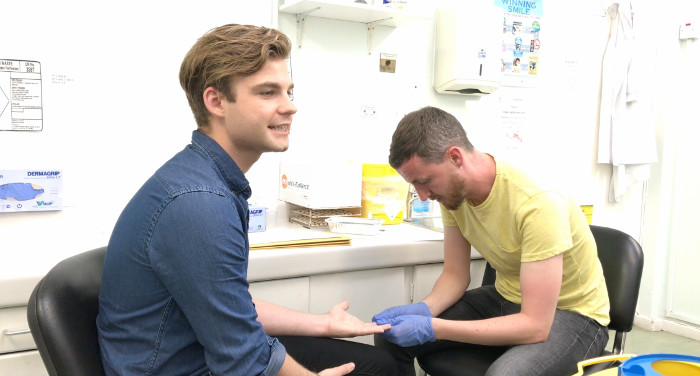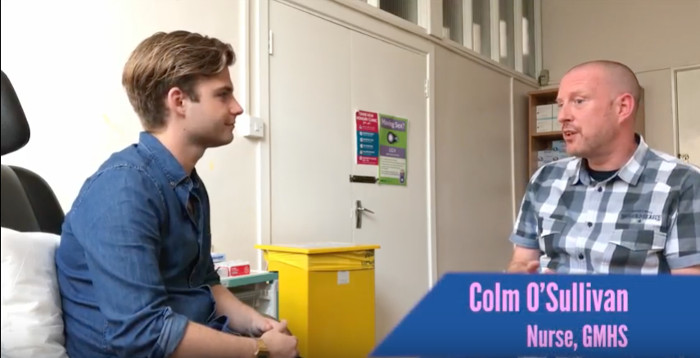As Stephen confirmed in a video on Facebook it was quick, straightforward and “I didn’t even have to take any clothes off.”
Stephen began his visit to Dublin’s Baggot Street clinic with a chat with GMHS manager Siobhan O’Dea, who answered some of the most frequently asked questions about the service.

How Frequently Should You Get Tested?
Every 3 – 6 months, if you’re sexually active. However if you perceive a risk than you should get tested within two weeks.
“We would recommend that you get tested every three to six months if you’re sexually active on a regular basis, says O’Dea, GMHS manager. “However, if you perceive a risk you should get tested, you should get tested within two weeks of that risk. This is crucial because infections such as gonorrhoea and chlamydia can take up to two weeks before they will show up as positive.
If I’ve Been Sexually Active and There Are No Symptoms Should I Still Get Tested?
Absolutely.
“The big problem with chlamydia and gonorrhoea and also with HIV and syphilis is that sometimes these infections don’t have any symptoms,” explains O’Dea. “As high as 60% of men who have sex with men (MSMs) who have chlamydia and gonorrhoea don’t have any symptoms.
“You could be carrying the infection and not realise you have it. So, even if you don’t have symptoms, you should get tested.”
If I Come In And I Do Test Positive For An STI, What’s The Procedure?
If test positive for an STI, someone from the clinic will call and arrange for you to come in when a doctor is present, and you will be given treatment – usually in the form of antibiotics – for free.
“The testing here is free, the treatment is also free. So if you test positive for an STI, we will ring you and arrange for you to come in during one of our clinics.
“We have a doctor on duty, it’s usually on Tuesdays evenings or Wednesday evenings and we will give you the treatment for free. Depending on the STI you have, the treatment is generally antibiotics. Most of the time oral antibiotics, however sometimes you may have to get an injection.”
Rapid HIV Testing
Adam Shanley, outreach worker for GMHS, walks Stephen through the steps involved in getting Rapid HIV Testing.

How Does It Work?
A pin-prick sample of blood is taken from the tip of your finger.
“What I am gonna do is clean the tip of your finger and prick the side of it so blood will come to the surface,” Shanley explains. “I’ll take a sample of that blood, I’ll put it into a test, you go off and to the rest of your tests and by the time you get back to me I’ll have the result for HIV.”
Does It Hurt?
Not really – it feels like a paper cut.
How Long Does It Take To Get A Result?
About 20 minutes.
“The blood goes on to this strip and over 20 minutes a result develops,” says Shanley. “What we want to see is one red line, that means the test has worked.” If there are any other lines adds Shanley, this means HIV is present.
While waiting for the results, Stephan asks Shanley about the U=U Campaign. “It means ‘Undetectable equals transmittable’. So basically, if you’re HIV positive and you’re taking your meds every day, it actually lowers the amount of virus in your blood to an undetectable level, so it means you can’t pass on HIV to anybody else.
“So, it’s a really important milestone for many HIV positive to get to, but also for HIV negative people to know that their HIV positive partners won’t pass it on.”

What’s the Difference Between PeP and PrEP?
PEP is for after potential exposure, while PrEP is for before.
With Pep you take 28 days of HIV meds (2 pills a day) to stop HIV infection if you’ve been exposed to a credible risk over the preceding 72 hours. You can get it at sexual health clinics or A&E.
With PrEP, you take one pill every day which considerably reduces the risk of contracting HIV.
——
Next, Stephen meets GMHS nurse Colm O’Sullivan for more extensive blood screening, which will test for HIV and Hepatitis A, B and C. Stephen is given a rectal and oral swab, as well as a urine test. The swabs are tested for chlamydia and gonorrhoea.

Is The Service Confidential?
It is 100% confidential and free.
How Can You Protect Yourself Against STIs?
The HSE cites proper condom use as an important tool to protect against STIs, as well as availing of vaccines (such as the Hep A, B and HPV).
A swab is taken from three areas in the throat, then you are sent into the bathroom with instructions on how to use the rectal swabs and a urine sample container.
These results will take about a week to come back. The Rapid HIV test takes just 20 minutes.
At the end of the video, Stephen catches back up with Adam Shanley for the results of his Rapid HIV test. Stephen’s test results come back negative and Shanley explains that the other test results will take up to a week to come back. “We’ll text you if everything is okay,” says Shanley, “and we’ll give you a call if we need you to come back in.”
So there it is: a visit to the GMHS clinic is simple, straightforward and not at all scary.
Stephen is over in Stockholm vying for the title of Mr Gay Europe this weekend and we really hope he snatches that crown. Go n-eirí an tádh leat, Stephen!
© 2017 GCN (Gay Community News). All rights reserved.
